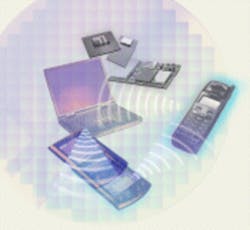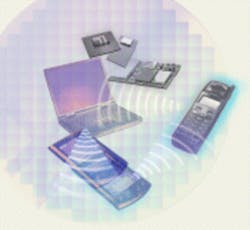Formulating Bluetooth Manufacturing Test Strategies
OEMs taking that step, however, face some complex testing issues and likely have many questions such as: What parts of a system and which parameters need testing? Who conducts those tests? If I’m responsible, how do I go about performing those tests? To what degree are test procedures standardized? Must I have tests verified, and if so, by whom? Can existing lab equipment handle these tests, or must I purchase specialized instruments?
Key RF Characteristics
Testing becomes more complex because of the sophisticated nature of Bluetooth communications. The scheme relies on Gaussian frequency shift keying (GFSK) and uses two closely spaced frequencies to represent a zero or one. The peak allowable frequency deviation from the carrier is 175 kHz.
Unlike standard FSK, GFSK uses a Gaussian filter prior to modulation and transmission. This step rounds off each pulse the transmitter places on the carrier, reducing spectral width and allowing the signal to fit more efficiently into a smaller frequency band.
You’ll also see the term BT = 0.5 in reference to Bluetooth modulation. It refers to the bandwidth-time product, a design parameter that dictates the time spread of the frequency-shaping pulse. It is the product of the 3-dB baseband bandwidth of the Gaussian filter and the bit duration. Limiting the value to 0.5 results in a more gradual frequency transition and decreases the interference with adjacent channels.
Because it is more immune to additive amplitude noise, an FSK-based method generally reduces the potential for interference. Bluetooth goes a step further by using a frequency-hopping scheme. Employing 1,600 hops/s in a pseudorandom sequence, the transmitter alternates among 79 carrier frequencies in the 2.402- to 2.480-GHz range, with a channel-to-channel spacing of 1 MHz.
As for data throughput, the base rate is 1 Msymbols/s. However, because of protocol overhead, the effective data throughput is somewhat lower. The asynchronous channel supports an asymmetric link of maximally 721 kbits/s in one direction while permitting 57.6 kbits/s in the return direction. The alternative is a 432.6-kbits/s symmetric link.
Finally, the Bluetooth specification allows three classes of devices based on power output, with the maximum permissible level being Class 1 at 100 mW (+20 dBm). At this power, the specification indicates an operating range of 100 m.
Before putting a Bluetooth device on the market, a manufacturer must verify the performance of both its transmitter and receiver. On the receive side, the bit error rate (BER) is the criterion used to measure performance, and you must test the unit’s sensitivity under a variety of conditions for various types of packets.
Because of the availability of pretested radio components and subsystems, in principal, OEMs should not worry about production testing of every single parameter in the Bluetooth specification. Instead, manufacturers of ICs and modules must make sure their wares meet certain standards before they can have their products added to the list of officially approved Bluetooth products. For the latest list, check the Qualified Products tab on www.bluetooth.com.
Focus on RF Performance
Manufacturing test must devote more time to measuring RF performance, which can vary widely depending on the final system configuration, its construction, the application, and which Bluetooth functionality is designed in. The testing of most RF communications devices generally involves measuring critical frequency-dependent parameters, and Bluetooth devices are no exception.
Transmitter specifications of concern include frequency accuracy, modulation quality, and spurious output levels. Transmitters must adhere to the following values: initial center-frequency accuracy of ±75 kHz for all design conditions such as variations in temperature or power-supply voltage. There is an additional allowance for intrapacket drift, which carries a separate specification from ±25 kHz to ±40 kHz depending on packet size, with a maximum drift rate of 400 Hz/ms.
Another aspect concerns whether all the output power falls within the proper frequency band and if the system adequately attenuates spurious emissions, both in and out of band (Figure 1). The in-band emissions are those that arise in Bluetooth band channels, and they must stay below -20 dBc within ±500 kHz, at -20 dBm within two adjacent channels, and -40 dBm within three channels. While the major factors in determining in-band emissions reside in the quality of the oscillators in the radio, external influences such as high-frequency power supply noise also can contribute to failure in meeting this specification.
For out-of-band emissions, power measurements generally are made in a 100-kHz bandwidth, although wider bandwidths might be useful for expediting some tests. In the operational mode, allowable power levels in a 100-kHz bandwidth range from -30 dBm to -47 dBm depending on frequency in the 30-MHz to 12.75-GHz range.
Shielded Test Environment
To test with controlled interference and prevent interference with other nearby testing activities, it’s important to conduct some tests in a shielded environment. The ideal environment for such tests is a laboratory anechoic chamber, but it’s not practical for manufacturing firms to maintain such an expensive and awkward facility for high-volume manufacturing test.
An alternative to a room-size anechoic chamber is a miniature version in the form of a shielded enclosure. Such compact, off-the-shelf test chambers can provide excellent results with acceptable cost.
Designed for volume manufacturing, engineering development, and precompliance testing, these products are customizable to suit a broad range of EUT requirements and provide accurate and repeatable measurements, galvanic or radiated. However, you must be fully aware of certain effects. For instance, reflections within shielded enclosures can generate standing waves that, in turn, distort test results, especially if the EUT incorporates an integral antenna. Moreover, it’s critical to manage other effects such as internal RF propagation characteristics, antenna loading, and RF chamber leakage.
New Testers Prove Critical
No matter what the test environment, some Bluetooth tests require capabilities typically not found in instruments from even a few years ago. For instance, recalling that Bluetooth is a frequency-modulated scheme, consider the capabilities of a traditional spectrum analyzer. It only measures the frequency components that are present and gives no indication about when or in what sequence they occur. For full Bluetooth characterization, that information is vital.
To address that need, test-equipment suppliers offer add-in modules that enable their spectrum analyzers to handle such tasks. For instance, Figure 2 shows the display of an Agilent Technologies ESA-E Series Spectrum Analyzer equipped with a Bluetooth measurement option displaying frequency deviation vs. time. The first several cycles represent synchronization pulses, and the varying width pulses that follow correspond to data.
It would be impossible to view these pulses in a standard spectrum analyzer, since it simply would show the carrier and some sidebands. In this case, though, the instrument starts by giving the value of the center frequency or 2.402 GHz. You can next see that the deviation for wide pulses is larger than for narrow ones, a desirable effect due to Gaussian filtering. If narrow pulses have too much deviation, they produce more sideband energy, potentially creating adjacent-channel interference.
Finally, you could slow down the sweep rate so more pulses appeared on the display. In this way, you could see if the entire data packet exhibits any frequency drift.
Rather than outfit a spectrum analyzer to handle such tasks, communications engineers have many other options. Test-equipment houses recently developed a new class of instrument known as the vector signal analyzer. Such powerful boxes allow engineers to analyze burst, transient, or modulated signals with simultaneous views of time, frequency, phase, and amplitude. Taking the concept of these general-purpose units even further, you now can find instruments targeted at Bluetooth testing.
Choose Your Tests Wisely
Even with such sophisticated systems, don’t expect an easy way to automate Bluetooth testing completely. Instead, the key is determining which of the many possible tests you actually need to conduct.
Consider an example dealing with RF power output, whose tests can take a surprising amount of time. As part of the test for power density, the Bluetooth Test Specification calls for a spectrum-analyzer sweep of 240 MHz at 100 kHz/s.
Running those numbers for just the power test—240 × 106/100 × 103 = 2,400 s—should help illustrate why a reasonably complete RF test according to the Bluetooth Test Specification would require many hours, if not days, to complete. Although OEMs are obligated to ensure that delivered products fully comply with the Bluetooth specification, this does not automatically require that every possible step be conducted at production test.
Once the design and production process is sufficiently validated, you must carefully select the appropriate subset of test cases and intelligently accelerate tests where possible to optimize production test beat rates. With the architecture and features of the end product in mind, a test team must review the Bluetooth test suites to determine which are applicable and appropriate. Making an intelligent selection, however, is a challenge.
For instance, the team must decide if they’re satisfied with the testing already conducted on the Bluetooth silicon and other critical components that influence RF performance. Any new silicon releases, particularly relating to RF, require a higher level of testing vigilance on the part of the OEM, at least until proven stable. In addition, when conducting tests, silicon vendors often select the optimum conditions, whereas the conditions under which you’ll use the chips will likely be far different.
To reduce testing time on the manufacturing floor, you might consider methodologies such as marginalized testing that are particularly applicable to receivers. You could set the input power to the receiver at a level lower than the -70 dBm listed in the specification. If the unit functions well even with that lower power, you can be satisfied with its design.
In most cases, though, this reduction in signal level results in a higher BER. However, knowledge of the exact relationship between BER and input power allows an engineering team to extrapolate to higher power levels and reduce the testing time. The trick is establishing this relationship.
Indeed, devising an effective yet time-efficient Bluetooth test strategy can take considerable effort. However, especially at the manufacturing stage, the rewards are plentiful.
About the Authors
Bill Elder is co-founder and executive vice president of Maxsys Technologies,1770 Kettering, Irvine, CA 92614, 949-833-8834, e-mail: [email protected].
Bob Hay founded AlloSys in 1997 after working in R&D at Hewlett-Packard for 29 years. AlloSys, 5650 Fieldcrest Dr., Boise, ID 83704, 208-377-0246, e-mail: [email protected].
Return to EE Home Page
Published by EE-Evaluation Engineering
All contents © 2001 Nelson Publishing Inc.
No reprint, distribution, or reuse in any medium is permitted
without the express written consent of the publisher.
September 2001

